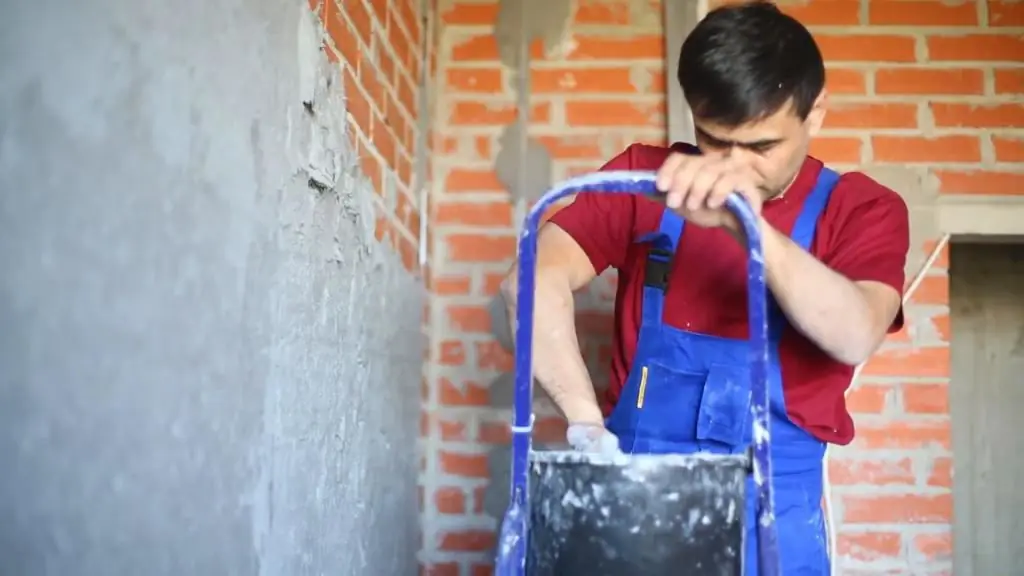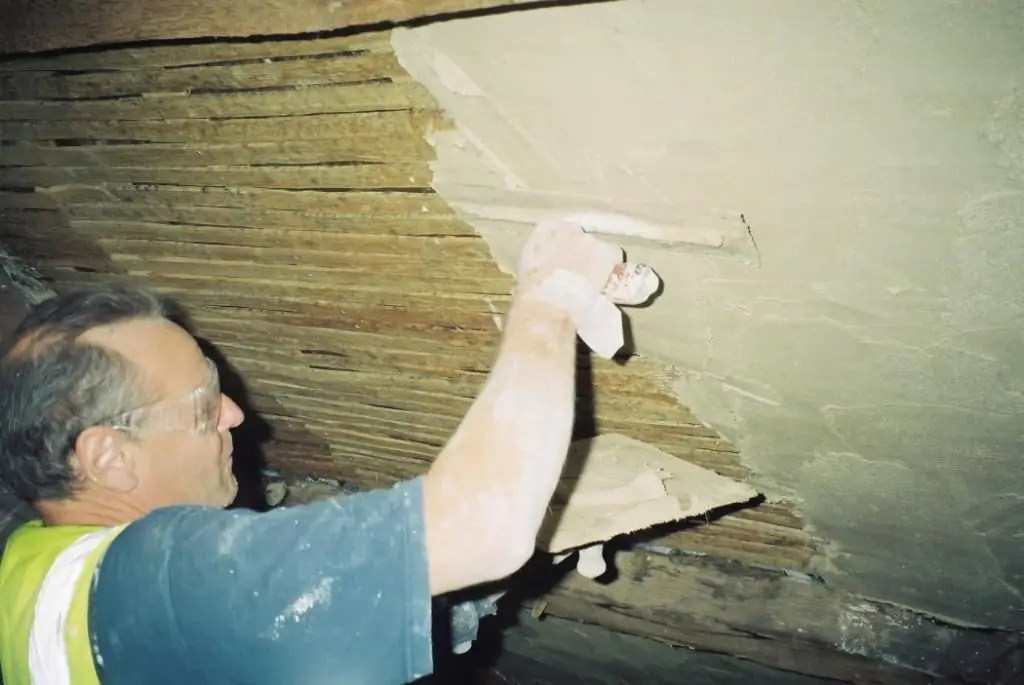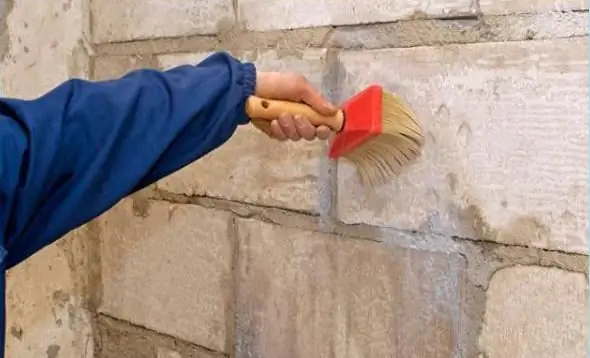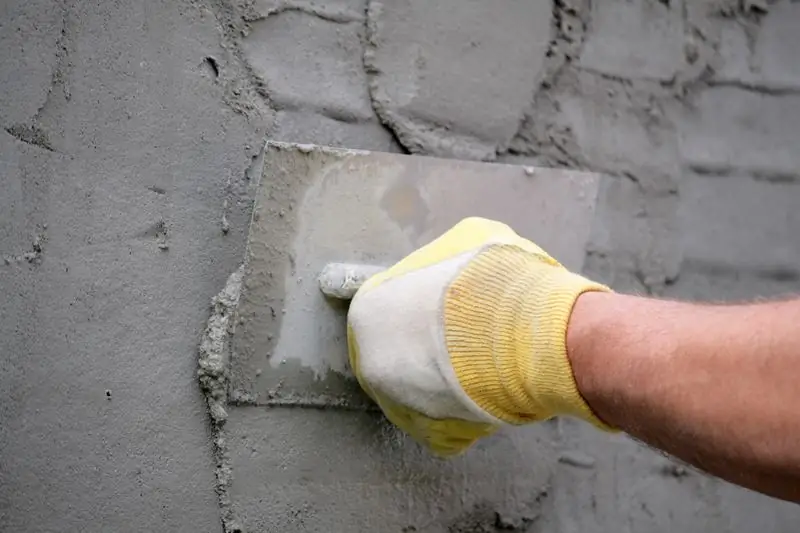In order for the plaster to be firmly attached to the wall, it is necessary to prepare the surfaces for plastering before applying it, since without this work there will be no reliable connection between the materials. If you apply a layer of mortar on an unprepared wall, it will first crack, and then it may even crumble. Therefore, before starting to plaster, it is necessary to determine what material the walls are made of, since different wall preparations are made for each of them. But at the same time, the main work for everyone is cleaning from dirt and dust, as well as leveling surfaces.

How to apply plaster on a brick wall?
This type of wall is the most common, so the preparation of brick surfaces for plastering is of great importance and is carried outas follows:
- If a brick wall is laid out with voids between the bricks, then such a wall should simply be cleaned of dust or treated with a special cleaning solution.
- After that, it is necessary to apply notches that will give the wall an additional roughness. This is necessary for good adhesion of the plaster to the wall.
- When the wall is laid out in such a way that all the distances between the materials are filled with cement, these lines need to be deepened by 10 mm. After that, all the distances between the bricks are thoroughly cleaned of the remnants of the knocked-out mortar. To do this, you need a metal brush.
- The next step in preparing brick surfaces for plastering is to clean the entire wall from dust. In the event that the brick wall does not have roughness, notches are made on it. This method will improve the adhesion of the wall to the plaster.
After the completion of these works and before the plastering process itself, the walls must be primed, and then wait for the primer to dry completely (after about 8-12 hours), and then you can start working with the mortar.

Concrete wall preparation method
In order for the preparation of concrete surfaces for plastering not to be useless, you need to know the following rules. Since this surface does not have roughness, the plaster does not adhere to it well, so notches must be applied. They are made with a hammer, a chisel, a grinder, and for large surfaces a puncher or a jackhammer is used. They are applied in order.chess and should be 4 mm. After the notches are ready, a metal mesh must be attached to the entire surface using dowels. At the same time, it must be pulled very securely along the wall. This is necessary in order to keep the solution well. After that, the entire surface should be plastered with a solution. It is not necessary to clean this surface, it must remain rough for the plaster to firmly adhere to it.

Preparing wood flooring
Let's consider how surfaces are prepared for plastering. Shingles are mainly applied to such a coating, but this method is now outdated, and plasterboard sheets are used for this purpose. When applying shingles, one even layer is first attached. You can use any board, even curved and rough. The second layer is flat planks. All these layers are fixed with nails. After installing the necessary layers, a metal mesh is attached to the outer part. During operation, each layer that is installed is treated with a special antiseptic. It will save the tree from fungus and moisture.
After installing the shingles, a layer of metal mesh is applied to it. This is done in the event that this ceiling or wall will later be subjected to facing work. If a layer of plaster will be applied to the surface, then the mesh is not needed.
What is mechanical plaster?
This is a type of surface plastering using a special machine. It has a container into which gypsum or cement plaster is poured,which automatically mixes with water.
Then, with the help of a special hose and dispenser, the finished mixture is fed onto the walls. It remains only to level it. This work is carried out by at least two people. This type of mechanized plastering is used for large areas that require plastering.
Thanks to the use of this technique, the speed of work is increased, the cost of dry mix is reduced, since for this machine they are cheaper than for plastering without equipment.
In addition, this process is much faster, since mechanical plaster is immediately applied to the wall, and leveled by another builder. Another advantage of such work is the absence of uneven areas, bumps and depressions that are obtained during manual work.
Accordingly, if you need to put a mortar in a new house, you can apply mechanical plaster. This method is also suitable for the construction of multi-storey cottages, offices, industrial buildings.

Why prepare walls before applying plaster?
Many non-construction people do not know that for high-quality plastering of walls, they must be properly prepared. Therefore, the importance of preparing surfaces for plastering is great, because if this work is not done, the mortar may first attach to the concrete wall, and after a while slide in layers, if not completely, then partially crack, begin to crumble. The reason for this process ispoor connection of the applied layer of gypsum or cement mixture with the surface.
Surfaces of walls and ceilings can be made of wood, brick, concrete, plasterboard, plastered. When preparing surfaces for plastering, these work areas must be thoroughly cleaned of dirt, eliminate all the flaws that are on their surface, and use the above tips on how to properly plaster each type of wall. It is better to spend time preparing than to redo all the work, and in the worst case, all repairs. Plaster is very important, because it is a wall decoration, and paint, wallpaper or other coatings are already applied to it. To apply these coatings and maintain the integrity of the entire room, due attention must be paid to these works.

Conclusion
So, we looked at how to prepare surfaces for plastering. After a repair done correctly, you can admire your work for a long time, and failures will bring not only disappointment, but also additional costs for eliminating all production errors.






